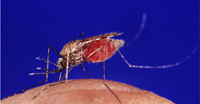|
Since
West Nile virus (WNV) was first isolated in 1937, it has
been known to cause asymptomatic infection and fevers in
humans in Africa, West Asia, and the Middle East. Human
and animal infections were not documented in the Western
Hemisphere until 1999. In 1999 and 2000, outbreaks of WNV
encephalitis (inflammation of the brain) were reported in
persons living in the New York City metropolitan area, New
Jersey, and Connecticut. In these two years, 83 human cases
of West Nile illness were reported; 9 died. In 2001, human
infection with WNV occurred in 10 states with 66 cases and
9 deaths. In 2002, WNV activity has spread to most eastern
and mid-western states, with 113 cases and 5 deaths as of
August 8.
WNV
is transmitted to humans through mosquito bites. Mosquitoes
become infected when they feed on infected birds that have
high levels of WNV in their blood. Infected mosquitoes can
then transmit WNV when they feed on humans or other animals.
WNV
is not transmitted from person to person and there is no
evidence that a person can get infected by handling live
or dead infected birds. But, to add a further level of safety,
if birds or other potentially infected animals must be handled,
a protective barrier (e.g., gloves, inverted plastic bags)
should be used.
Most
WNV infected humans have no symptoms. A small proportion
develops mild symptoms that include fever, headache, body
aches, skin rash and swollen lymph glands. Less than 1%
of infected people develop more severe illness that includes
meningitis (inflammation of the spinal cord) or encephalitis.
The symptoms of these illnesses can include headache, high
fever, neck stiffness, stupor, disorientation, coma, tremors,
convulsions, muscle weakness, and paralysis. Of the few
people that develop encephalitis, a small proportion die
but, overall, this is estimated to occur in less than 1
out of 1000 infections.
|
 |